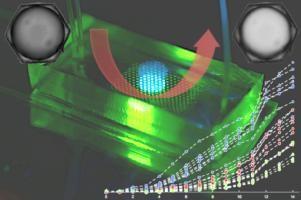
A microsystem for air quality measurements in future housing
At IUPAC 2019 Paris congress, Laurent Mugherli, from the Nanosciences and Innovation for Materials, Biomedicine and Energy Laboratory (NIMBE - CEA/CNRS), presented the work resulting from a collaboration with Charles Baroud's team from the Hydrodynamics Laboratory of the Ecole polytechnique (LADHYX - CNRS/Ecole polytechnique) on a new system for detecting formaldehyde present inside buildings.
By 2050, 68% of humanity will live in cities, creating some kind of "super cities" with more than 100 million inhabitants. For these urban dwellers, working time - or life - will be even more concentrated in indoor spaces. However, the presence of chemical pollutants is two to five times greater inside buildings than outside. One of the most common compounds, formaldehyde, is also a toxic one. Its detection is therefore important for everyone's health.
Currently, the amount of this compound in air is measured by using a pump that traps formaldehyde through a chemical reaction. The result of this reaction is then sent to an analytical laboratory to determine the amount of formaldehyde present. This method of quantification has several disadvantages: besides being indirect, it only provides its result after two weeks and the machines required for analysis are neither transportable nor miniaturisable.
Based on these findings, Laurent Mugherli and his colleagues at the Laboratory of Nanometric Constructions (CEA/CNRS) at the CEA in Saclay, developed, in collaboration with Charles Baroud's team at the Laboratory of Hydrodynamics of the Ecole Polytechnique (LADHYX - CNRS/Ecole Polytechnique), a new method for quantifying formaldehyde. It uses one of the principles of microfluidics and porous materials.

They developed a chip containing a material whose pores are filled with a formaldehyde-detecting molecule. It works very easily: the solution to be analysed goes through the chip and if it contains formaldehyde, it reacts with the detector molecules present in the pores. Then, a small apparatus detects and quantifies the product of this reaction. At the end, it determines the amount of formaldehyde present in solution. Due to the large number of pores present in the material, it is possible to obtain a direct and statistical measurement of the detected formaldehyde without having to make several separate measurements.
This new detection method is suitable for any kind of household environment and is very easy to use. For the time being, the proof of concept has been performed on formaldehyde present in the air. However, CEA researchers are also working to detect other pollutants in other mediums, such as water or soil.
Références :
L. Mugherli, A. Lety-Stefanska , N. Landreau , R. Tomasi , C. Baroud. A Microsystem for Air Quality Measurement in Future Housings. 47th IUPAC WORLD CHEMISTRY CONGRESS, Paris, FRANCE - 5-12 Juillet 2019.
